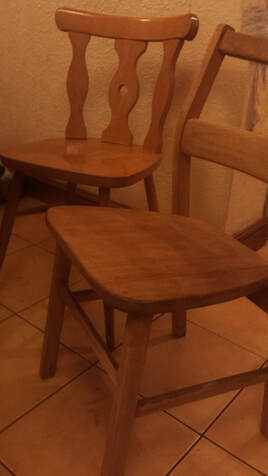
Every so often someone comes for a lesson and we start by looking at sitting in a chair. An everyday activity. They sit down but they are moving about, continually adjusting themselves. They seem to be having trouble sitting comfortably, but I can't be sure.
So I ask them; is everything ok? and they say that the chair is not comfortable. As we talk it becomes clear that there is something wrong with the design of the chair.
Either the seat slopes back or the back of the chair sticks in to the spine in a way that is not very friendly. or its too high or too low. something is not good about the chair. It's a bad chair.
I am interested in what people have to say. I hope I listen to what people say and how they say it. It's always a good place to start in any conversation.
We do some Alexander Technique work sitting in the chair.
Everything changes. They are more comfortable. Sometimes they are very comfortable. The chair is comfortable. It's a good chair.
It's the same chair. Nothing has changed about the chair.
I like this.
I like that change can happen so quickly.
Sometimes it seems to me that when we sit on a chair it's almost as if we are stacking one rigid chair on top of the other.We have a strong tendency to ascribe our problems to external forces, in this case the chair.
FM Alexander writing over a hundred years ago said that he was continually being asked for his opinion on the correct type of chair, desk , table, stool that one should use in order 'to prevent the bad habits which these pieces of furniture are supposed to have caused. '
Let us suppose, he writes, that there is an ideal chair that would correct the postural problems in the individual. Does this mean that the person when visiting a friend, going on a picnic and so on, must carry this 'good chair' around with them at all times to save themselves from the horrors and attendant suffering from malevolent furniture?
'Bad chair.'
We do have a tendency to anthropomorphise and to attribute consciousness to objects. It would certainly make life more interesting if we had to ask permission of our furniture before we sat down and ate our food at the table. However rather than educate our furniture in being more obliging and comfortable maybe we could educate ourselves in how to use our body so that we can adapt to whatever environment or circumstance(or chair) we may encounter.
We have a structure , just like the chair, that supports us. It is a flexible structure, unlike the chair, that we can move about and adapt to any piece of furniture or activity, and be comfortable.
We can learn to do this with The Alexander Technique.
So I ask them; is everything ok? and they say that the chair is not comfortable. As we talk it becomes clear that there is something wrong with the design of the chair.
Either the seat slopes back or the back of the chair sticks in to the spine in a way that is not very friendly. or its too high or too low. something is not good about the chair. It's a bad chair.
I am interested in what people have to say. I hope I listen to what people say and how they say it. It's always a good place to start in any conversation.
We do some Alexander Technique work sitting in the chair.
Everything changes. They are more comfortable. Sometimes they are very comfortable. The chair is comfortable. It's a good chair.
It's the same chair. Nothing has changed about the chair.
I like this.
I like that change can happen so quickly.
Sometimes it seems to me that when we sit on a chair it's almost as if we are stacking one rigid chair on top of the other.We have a strong tendency to ascribe our problems to external forces, in this case the chair.
FM Alexander writing over a hundred years ago said that he was continually being asked for his opinion on the correct type of chair, desk , table, stool that one should use in order 'to prevent the bad habits which these pieces of furniture are supposed to have caused. '
Let us suppose, he writes, that there is an ideal chair that would correct the postural problems in the individual. Does this mean that the person when visiting a friend, going on a picnic and so on, must carry this 'good chair' around with them at all times to save themselves from the horrors and attendant suffering from malevolent furniture?
'Bad chair.'
We do have a tendency to anthropomorphise and to attribute consciousness to objects. It would certainly make life more interesting if we had to ask permission of our furniture before we sat down and ate our food at the table. However rather than educate our furniture in being more obliging and comfortable maybe we could educate ourselves in how to use our body so that we can adapt to whatever environment or circumstance(or chair) we may encounter.
We have a structure , just like the chair, that supports us. It is a flexible structure, unlike the chair, that we can move about and adapt to any piece of furniture or activity, and be comfortable.
We can learn to do this with The Alexander Technique.
 RSS Feed
RSS Feed
